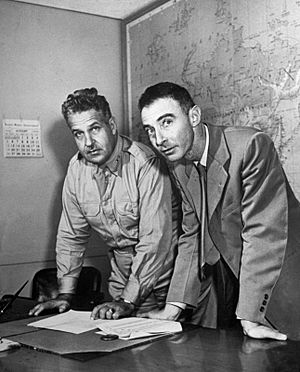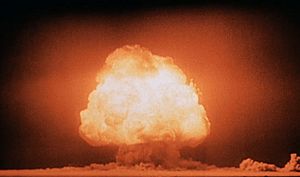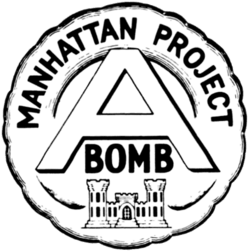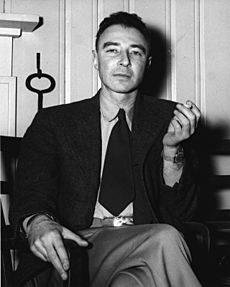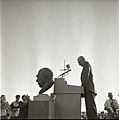J. Robert Oppenheimer facts for kids
Quick facts for kids
J. Robert Oppenheimer
|
|
|---|---|
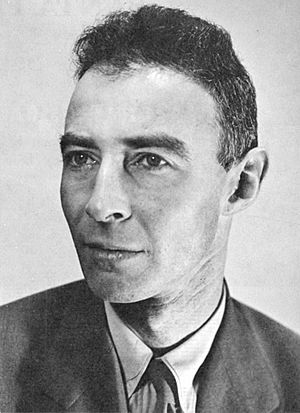
J. Robert Oppenheimer, c. 1944
|
|
| Born | April 22, 1904 |
| Died | February 18, 1967 (aged 62) |
| Nationality | American |
| Alma mater | Harvard College Christ's College, Cambridge University of Göttingen |
| Known for | Nuclear weapons development Tolman–Oppenheimer–Volkoff limit Oppenheimer–Phillips process Born–Oppenheimer approximation |
| Spouse(s) | Katherine "Kitty" Puening Harrison (1940–1967; his death; 2 children) |
| Awards | Enrico Fermi Award (1963) |
| Scientific career | |
| Fields | Theoretical physics |
| Institutions | University of California, Berkeley California Institute of Technology Los Alamos Laboratory Institute for Advanced Study |
| Thesis | Zur Quantentheorie kontinuierlicher Spektren (1927) |
| Doctoral advisor | Max Born |
| Doctoral students | Samuel W. Alderson David Bohm Robert Christy Sidney Dancoff Stan Frankel Willis Eugene Lamb Harold Lewis Philip Morrison Arnold Nordsieck Melba Phillips Hartland Snyder George Volkoff |
| Signature | |
| Notes | |
|
Brother of physicist Frank Oppenheimer
|
|
Julius Robert Oppenheimer (April 22, 1904 – February 18, 1967) was an American theoretical physicist and professor of physics at the University of California, Berkeley. Oppenheimer was the wartime head of the Los Alamos Laboratory and is among those who are credited with being the "father of the atomic bomb" for their role in the Manhattan Project, the World War II undertaking that developed the first nuclear weapons used in the atomic bombings of Hiroshima and Nagasaki. The first atomic bomb was detonated on July 16, 1945, in the Trinity test in New Mexico; Oppenheimer later remarked:
"We knew the world would not be the same", he recalled the moments after the successful testing of the atomic bomb in New Mexico, United States years later. "A few people laughed, a few people cried, most people were silent. I remembered the line from the Hindu scripture, the Bhagavad-Gita. Vishnu is trying to persuade the Prince that he should do his duty and to impress him takes on his multi-armed form and says, 'I am become Death, the destroyer of worlds.' I suppose we all thought that one way or another." The quote from the Hindu scripture became one of Oppenheimer's most famous quotes.
After the war ended, Oppenheimer became chairman of the influential General Advisory Committee of the newly created United States Atomic Energy Commission. He used that position to lobby for international control of nuclear power to avert nuclear proliferation and a nuclear arms race with the Soviet Union. After provoking the ire of many politicians with his outspoken opinions during the Second Red Scare, he suffered the revocation of his security clearance in a much-publicized hearing in 1954, and was effectively stripped of his direct political influence; he continued to lecture, write and work in physics. Nine years later, President John F. Kennedy awarded (and Lyndon B. Johnson presented) him with the Enrico Fermi Award as a gesture of political rehabilitation.
Oppenheimer's achievements in physics included the Born–Oppenheimer approximation for molecular wave functions, work on the theory of electrons and positrons, the Oppenheimer–Phillips process in nuclear fusion, and the first prediction of quantum tunneling. With his students he also made important contributions to the modern theory of neutron stars and black holes, as well as to quantum mechanics, quantum field theory, and the interactions of cosmic rays. As a teacher and promoter of science, he is remembered as a founding father of the American school of theoretical physics that gained world prominence in the 1930s. After World War II, he became director of the Institute for Advanced Study in Princeton, New Jersey.
Contents
Early life
Oppenheimer was born in New York City on April 22, 1904, to Julius Oppenheimer, a wealthy Jewish textile importer who had immigrated to the United States from Germany in 1888, and Ella Friedman, a painter. Julius came to America with no money, no education, and no knowledge of the English language. He got a job in a textile company and within a decade was an executive with the company. The Oppenheimers were non-observant Ashkenazi Jews. In 1912 the family moved to an apartment on the 11th floor of 155 Riverside Drive, near West 88th Street, Manhattan, an area known for luxurious mansions and townhouses. Their art collection included works by Pablo Picasso and Édouard Vuillard, and at least three original paintings by Vincent van Gogh. Robert had a younger brother, Frank, who also became a physicist.
Education
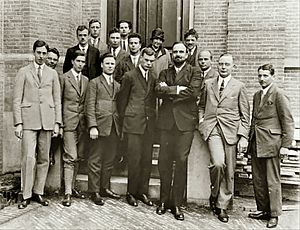
Oppenheimer was a versatile scholar, interested in English and French literature, and particularly in mineralogy. He completed the third and fourth grades in one year, and skipped half the eighth grade. During his final year, he became interested in chemistry. He entered Harvard College one year after graduation, at age 18, because he suffered an attack of colitis while prospecting during a family summer vacation in Europe. To help him recover from the illness, his father enlisted the help of his English teacher Herbert Smith who took him to New Mexico, where Oppenheimer fell in love with horseback riding and the southwestern United States.
Oppenheimer majored in chemistry, but Harvard required science students to also study history, literature, and philosophy or mathematics. He compensated for his late start by taking six courses each term and was admitted to the undergraduate honor society Phi Beta Kappa. In his first year, he was admitted to graduate standing in physics on the basis of independent study, which meant he was not required to take the basic classes and could enroll instead in advanced ones. He was attracted to experimental physics by a course on thermodynamics that was taught by Percy Bridgman. He graduated in three years.
Oppenheimer was a tall, thin chain smoker with deep psychological troubles. Throughout his life, Oppenheimer was plagued by periods of depression, and he once told his brother, "I need physics more than friends".
In 1926, Oppenheimer left Cambridge for the University of Göttingen to study under Max Born. Göttingen was one of the world's leading centers for theoretical physics. He was known for being too enthusiastic in discussion, sometimes to the point of taking over seminar sessions. This irritated some of Born's other students so much that Maria Goeppert presented Born with a petition signed by herself and others threatening a boycott of the class unless he made Oppenheimer quiet down. Born left it out on his desk where Oppenheimer could read it, and it was effective without a word being said.
He obtained his Doctor of Philosophy degree in March 1927 at age 23, supervised by Born. Oppenheimer published more than a dozen papers at Göttingen, including many important contributions to the new field of quantum mechanics.
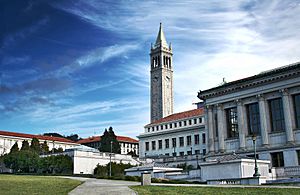
On returning to the United States, Oppenheimer accepted an associate professorship from the University of California, Berkeley, where Raymond T. Birge wanted him so badly that he expressed a willingness to share him with Caltech.
Before his Berkeley professorship began, Oppenheimer was diagnosed with a mild case of tuberculosis and spent some weeks at a ranch in New Mexico, which he leased and eventually purchased. When he heard the ranch was available for lease, he exclaimed, "Hot dog!", and later called it Perro Caliente, literally "hot dog" in Spanish. Later he used to say that "physics and desert country" were his "two great loves". He recovered from the tuberculosis and returned to Berkeley, where he prospered as an adviser and collaborator to a generation of physicists who admired him for his intellectual virtuosity and broad interests. His students and colleagues saw him as mesmerizing: hypnotic in private interaction, but often frigid in more public settings.
Probably the most important ingredient he brought to his teaching was his exquisite taste. He always knew what were the important problems, as shown by his choice of subjects. He truly lived with those problems, struggling for a solution, and he communicated his concern to the group. In its heyday, there were about eight or ten graduate students in his group and about six Post-doctoral Fellows. He met this group once a day in his office, and discussed with one after another the status of the student's research problem. He was interested in everything, and in one afternoon they might discuss quantum electrodynamics, cosmic rays, electron pair production and nuclear physics.
He worked closely with Nobel Prize-winning experimental physicist Ernest O. Lawrence and his cyclotron pioneers, helping them understand the data their machines were producing at the Lawrence Berkeley National Laboratory. In 1936 Berkeley promoted him to full professor at a salary of $3300 per annum.
Scientific work
Oppenheimer did important research in theoretical astronomy (especially as related to general relativity and nuclear theory), nuclear physics, spectroscopy, and quantum field theory, including its extension into quantum electrodynamics. The formal mathematics of relativistic quantum mechanics also attracted his attention, although he doubted its validity. His work predicted many later finds, which include the neutron, meson and neutron star.
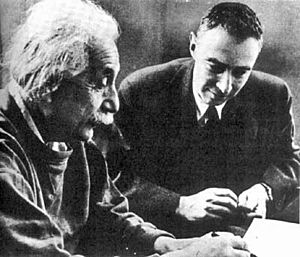
Oppenheimer also made important contributions to the theory of cosmic ray showers and started work that eventually led to descriptions of quantum tunneling. Oppenheimer worked with his first doctoral student, Melba Phillips, on calculations of artificial radioactivity under bombardment by deuterons, he and Phillips worked out a theory now known as the Oppenheimer–Phillips process to explain the results, a theory still in use today.
In the late 1930s Oppenheimer became interested in astrophysics, resulting in a series of papers. In the first of these, a 1938 paper co-written with Robert Serber entitled "On the Stability of Stellar Neutron Cores", Oppenheimer explored the properties of white dwarfs. This was followed by a paper co-written with one of his students, "On Massive Neutron Cores", in which they demonstrated that there was a limit, the so-called Tolman–Oppenheimer–Volkoff limit, to the mass of stars beyond which they would not remain stable as neutron stars and would undergo gravitational collapse.
Finally, in 1939, Oppenheimer and another of his students, Hartland Snyder, produced a paper "On Continued Gravitational Attraction", which predicted the existence of what are today known as black holes. After the Born–Oppenheimer approximation paper, these papers remain his most cited, and were key factors in the rejuvenation of astrophysical research in the United States in the 1950s.
Oppenheimer's papers were considered difficult to understand even by the standards of the abstract topics he was expert in. He was fond of using elegant, if extremely complex, mathematical techniques to demonstrate physical principles, though he was sometimes criticized for making mathematical mistakes, presumably out of haste. "His physics was good", said his student Snyder, "but his arithmetic awful".
Oppenheimer's diverse interests sometimes interrupted his focus on science. In 1933 he learned Sanskrit and met the Indologist Arthur W. Ryder at Berkeley. He read the Bhagavad Gita in the original Sanskrit, and later he cited it as one of the books that most shaped his philosophy of life.
If he had lived long enough to see his predictions substantiated by experiment, Oppenheimer might have won a Nobel Prize for his work on gravitational collapse, concerning neutron stars and black holes. In retrospect, some physicists and historians consider this to be his most important contribution, though it was not taken up by other scientists in his own lifetime. The physicist and historian Abraham Pais once asked Oppenheimer what he considered to be his most important scientific contributions; Oppenheimer cited his work on electrons and positrons, not his work on gravitational contraction. Oppenheimer was nominated for the Nobel Prize for physics three times, in 1945, 1951 and 1967, but never won.
Private and political life
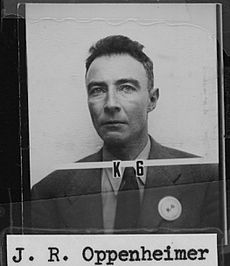
During the 1920s, Oppenheimer remained uninformed on worldly matters. He claimed that he did not read newspapers or listen to the radio, and had only learned of the Wall Street crash of 1929 some six months after it occurred while on a walk with Ernest Lawrence. He once remarked that he never cast a vote until the 1936 election. However, from 1934 on, he became increasingly concerned about politics and international affairs. In 1934, he earmarked three percent of his salary—about $100 a year—for two years to support German physicists fleeing from Nazi Germany.
Oppenheimer's mother died in 1931, and he became closer to his father who, although still living in New York, became a frequent visitor in California. When his father died in 1937 leaving $392,602 to be divided between Oppenheimer and his brother Frank, Oppenheimer immediately wrote out a will leaving his estate to the University of California for graduate scholarships. Like many young intellectuals in the 1930s, he supported social reforms that were later alleged to be communist ideas.
Manhattan Project
Los Alamos
On October 9, 1941, shortly before the United States entered World War II, President Franklin D. Roosevelt approved a crash program to develop an atomic bomb. In May 1942, National Defense Research Committee Chairman James B. Conant, who had been one of Oppenheimer's lecturers at Harvard, invited Oppenheimer to take over work on fast neutron calculations, a task that Oppenheimer threw himself into with full vigor.
He was given the title "Coordinator of Rapid Rupture", specifically referring to the propagation of a fast neutron chain reaction in an atomic bomb. One of his first acts was to host a summer school for bomb theory at his building in Berkeley. The mix of European physicists and his own students busied themselves calculating what needed to be done, and in what order, to make the bomb.
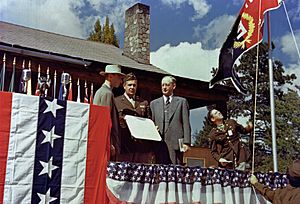
In June 1942, the US Army established the Manhattan Engineer District to handle its part in the atom bomb project, beginning the process of transferring responsibility from the Office of Scientific Research and Development to the military. In September, Groves was appointed director of what became known as the Manhattan Project. Groves selected Oppenheimer to head the project's secret weapons laboratory, a choice which surprised many, as Oppenheimer had left-wing political views, and no record as a leader of large projects.
The fact that he did not have a Nobel Prize, and might not have the prestige to direct fellow scientists, did concern Groves. However, he was impressed by Oppenheimer's singular grasp of the practical aspects of designing and constructing an atomic bomb, and by the breadth of his knowledge. As a military engineer, Groves knew that this would be vital in an interdisciplinary project that would involve not just physics, but chemistry, metallurgy, ordnance and engineering. Groves also detected in Oppenheimer something that many others did not, an "overweening ambition" that Groves reckoned would supply the drive necessary to push the project to a successful conclusion.
Oppenheimer and Groves decided that for security and cohesion they needed a centralized, secret research laboratory in a remote location. Scouting for a site in late 1942, Oppenheimer was drawn to New Mexico, not far from his ranch. He suggested and championed a site that he knew well: a flat mesa near Santa Fe, New Mexico, which was the site of a private boys' school called the Los Alamos Ranch School. The engineers were concerned about the poor access road and the water supply, but otherwise felt that it was ideal. The Los Alamos Laboratory was built on the site of the school, taking over some of its buildings, while many others were erected in great haste. There Oppenheimer assembled a group of the top physicists of the time, which he referred to as the "luminaries".
Initially Los Alamos was supposed to be a military laboratory, the plan to commission scientists fell through. Conant, Groves, and Oppenheimer devised a compromise whereby the laboratory was operated by the University of California under contract to the War Department. It soon turned out that Oppenheimer had hugely underestimated the magnitude of the project; Los Alamos grew from a few hundred people in 1943 to over 6,000 in 1945.
Oppenheimer at first had difficulty with the organizational division of large groups, but rapidly learned the art of large-scale administration after he took up permanent residence on the mesa. He was noted for his mastery of all scientific aspects of the project and for his efforts to control the inevitable cultural conflicts between scientists and the military. He was an iconic figure to his fellow scientists, as much a symbol of what they were working toward as a scientific director. Victor Weisskopf put it thus:
Oppenheimer directed these studies, theoretical and experimental, in the real sense of the words. Here his uncanny speed in grasping the main points of any subject was a decisive factor; he could acquaint himself with the essential details of every part of the work.
He did not direct from the head office. He was intellectually and physically present at each decisive step. He was present in the laboratory or in the seminar rooms, when a new effect was measured, when a new idea was conceived. It was not that he contributed so many ideas or suggestions; he did so sometimes, but his main influence came from something else. It was his continuous and intense presence, which produced a sense of direct participation in all of us; it created that unique atmosphere of enthusiasm and challenge that pervaded the place throughout its time.
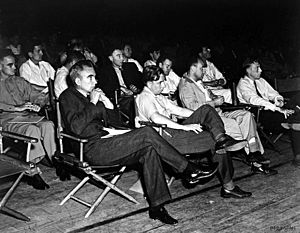
In 1943 development efforts were directed to a plutonium gun-type fission weapon called "Thin Man". When Los Alamos received the first sample of plutonium from the X-10 Graphite Reactor in April 1944 a problem was discovered: reactor-bred plutonium had a higher concentration of plutonium-240, making it unsuitable for use in a gun-type weapon. In July 1944, Oppenheimer abandoned the gun design in favor of an implosion-type weapon.
In August 1944 Oppenheimer implemented a reorganization of the Los Alamos laboratory to focus on implosion. He concentrated the development efforts on the gun-type device, a simpler design that only had to work with uranium-235, and this device became Little Boy in February 1945. After a mammoth research effort, the more complex design of the implosion device, known as the "Christy gadget" after Robert Christy, another student of Oppenheimer's, was finalized in a meeting in Oppenheimer's office on February 28, 1945.
In May 1945 an Interim Committee was created to advise and report on wartime and postwar policies regarding the use of nuclear energy. In its presentation to the Interim Committee the scientific panel offered its opinion not just on the likely physical effects of an atomic bomb, but on its likely military and political impact. This included opinions on such sensitive issues as whether or not the Soviet Union should be advised of the weapon in advance of its use against Japan.
Trinity
The joint work of the scientists at Los Alamos resulted in the first artificial nuclear explosion near Alamogordo on July 16, 1945, on a site that Oppenheimer codenamed "Trinity" in mid-1944. He later said this name was from one of John Donne's Holy Sonnets.
Oppenheimer later recalled that, while witnessing the explosion, he thought of a verse from the Bhagavad Gita (XI,12):
If the radiance of a thousand suns were to burst at once into the sky, that would be like the splendor of the mighty one...
Years later he would explain that another verse had also entered his head at that time: namely, the famous verse: "I am become Death, the destroyer of worlds."
According to his brother, at the time Oppenheimer simply exclaimed, "It worked." A contemporary account by Brigadier General Thomas Farrell, who was present in the control bunker at the site with Oppenheimer, summarized his reaction as follows:
Dr. Oppenheimer, on whom had rested a very heavy burden, grew tenser as the last seconds ticked off. He scarcely breathed. He held on to a post to steady himself. For the last few seconds, he stared directly ahead and then when the announcer shouted "Now!" and there came this tremendous burst of light followed shortly thereafter by the deep growling roar of the explosion, his face relaxed into an expression of tremendous relief.
Physicist Isidor Rabi noticed Oppenheimer's triumph: "I'll never forget his walk; I'll never forget the way he stepped out of the car... his walk was like High Noon... this kind of strut. He had done it."
At an assembly at Los Alamos on August 6 (the evening of the atomic bombing of Hiroshima), Oppenheimer took to the stage and clasped his hands together "like a prize-winning boxer" while the crowd cheered. He noted his regret the weapon had not been available in time to use against Nazi Germany. However, he and many of the project staff were very upset about the bombing of Nagasaki, as they did not feel the second bomb was necessary from a military point of view.
He traveled to Washington on August 17 to hand-deliver a letter to Secretary of War Henry L. Stimson expressing his revulsion and his wish to see nuclear weapons banned. In October 1945 Oppenheimer was granted an interview with President Harry S Truman. The meeting, however, went badly, after Oppenheimer remarked he felt he had "blood on my hands". The remark infuriated Truman and put an end to the meeting. For his services as director of Los Alamos, Oppenheimer was awarded the Medal for Merit from President Harry S Truman in 1946.
Postwar activities
The Manhattan Project became public knowledge after the bombings of Hiroshima and Nagasaki, and Oppenheimer became a national spokesman for science. He became a household name and his face appeared on the covers of Life and Time. Nuclear physics became a powerful force as all governments of the world began to realize the strategic and political power that came with nuclear weapons. Like many scientists of his generation, he felt that security from atomic bombs would come only from a transnational organization such as the newly formed United Nations, which could institute a program to stifle a nuclear arms race.
Atomic Energy Commission
As a member of the Board of Consultants to a committee appointed by Truman, Oppenheimer strongly influenced the Acheson–Lilienthal Report. In this report, the committee advocated creation of an international Atomic Development Authority, which would own all fissionable material and the means of its production, such as mines and laboratories, and atomic power plants where it could be used for peaceful energy production.
Bernard Baruch was appointed to translate this report into a proposal to the United Nations, resulting in the Baruch Plan of 1946. The Baruch Plan introduced many additional provisions regarding enforcement, in particular requiring inspection of the Soviet Union's uranium resources. The Baruch Plan was seen as an attempt to maintain the United States' nuclear monopoly and was rejected by the Soviets. With this, it became clear to Oppenheimer that an arms race was unavoidable, due to the mutual suspicion of the United States and the Soviet Union, which even Oppenheimer was starting to distrust.
After the Atomic Energy Commission (AEC) came into being in 1947 as a civilian agency in control of nuclear research and weapons issues, Oppenheimer was appointed as the Chairman of its General Advisory Committee (GAC). From this position he advised on a number of nuclear-related issues, including project funding, laboratory construction and even international policy—though the GAC's advice was not always heeded.
As Chairman of the GAC, Oppenheimer lobbied vigorously for international arms control and funding for basic science, and attempted to influence policy away from a heated arms race. When the government questioned whether to pursue a crash program to develop an atomic weapon based on nuclear fusion—the hydrogen bomb—Oppenheimer initially recommended against it, though he had been in favor of developing such a weapon during the Manhattan Project.
He was motivated partly by ethical concerns, feeling that such a weapon could only be used strategically against civilian targets, resulting in millions of deaths. He and others were especially concerned about nuclear reactors being diverted from plutonium to tritium production. They were overridden by Truman, who announced a crash program after the Soviet Union tested their first atomic bomb in 1949. Oppenheimer and other GAC opponents of the project, felt personally shunned and considered retiring from the committee. They stayed on, though their views on the hydrogen bomb were well known.
In 1951, however, Edward Teller and mathematician Stanislaw Ulam developed what became known as the Teller-Ulam design for a hydrogen bomb. This new design seemed technically feasible and Oppenheimer changed his opinion about developing the weapon. As he later recalled:
The program we had in 1949 was a tortured thing that you could well argue did not make a great deal of technical sense. It was therefore possible to argue that you did not want it even if you could have it. The program in 1951 was technically so sweet that you could not argue about that. The issues became purely the military, the political and the humane problems of what you were going to do about it once you had it.
Security hearing
The FBI under J. Edgar Hoover had been following Oppenheimer since before the war, when he showed Communist sympathies as a professor at Berkeley. He had been under close surveillance since the early 1940s, his home and office bugged, his phone tapped and his mail opened. The FBI furnished Oppenheimer's political enemies with incriminating evidence about his Communist ties.
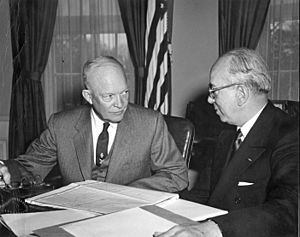
During his hearing, Oppenheimer testified willingly on the left-wing behavior of many of his scientific colleagues. Had Oppenheimer's clearance not been stripped then he might have been remembered as someone who had "named names" to save his own reputation. As it happened, Oppenheimer was seen by most of the scientific community as a martyr and a person who was unjustly attacked by warmongering enemies, symbolic of the shift of scientific creativity from academia into the military. Wernher von Braun said: "In England, Oppenheimer would have been knighted."
In a seminar at the Woodrow Wilson Institute on May 20, 2009, based on an extensive analysis of notebooks taken from the KGB archives, it was confirmed that Oppenheimer never was involved in espionage for the Soviet Union. The KGB tried repeatedly to recruit him, but was never successful; Oppenheimer did not betray the United States.
Final years and death
Starting in 1954, Oppenheimer lived for several months of the year on the island of Saint John in the U.S. Virgin Islands. In 1957, he purchased a 2-acre (0.81 ha) tract of land on Gibney Beach, where he built a spartan home on the beach. He spent a considerable amount of time sailing with his daughter Toni and wife Kitty.
Oppenheimer was increasingly concerned about the potential danger that scientific inventions could pose to humanity. He joined with Albert Einstein, Bertrand Russell, Joseph Rotblat and other eminent scientists and academics to establish what would eventually, in 1960, become the World Academy of Art and Science.
In his speeches and public writings, Oppenheimer continually stressed the difficulty of managing the power of knowledge in a world in which the freedom of science to exchange ideas was more and more hobbled by political concerns. Oppenheimer delivered the Reith Lectures on the BBC in 1953, which were subsequently published as Science and the Common Understanding. In 1955 Oppenheimer published The Open Mind, a collection of eight lectures that he had given since 1946 on the subject of nuclear weapons and popular culture.
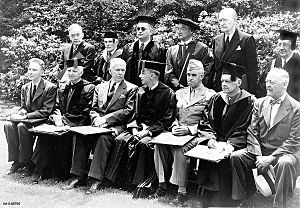
Deprived of political power, Oppenheimer continued to lecture, write and work on physics. He toured Europe and Japan, giving talks about the history of science, the role of science in society, and the nature of the universe. In September 1957, France made him an Officer of the Legion of Honor, and on May 3, 1962, he was elected a Foreign Member of the Royal Society in Britain.
At the urging of many of Oppenheimer's political friends who had ascended to power, President John F. Kennedy awarded Oppenheimer the Enrico Fermi Award in 1963 as a gesture of political rehabilitation. A little over a week after Kennedy's assassination, his successor, President Lyndon Johnson, presented Oppenheimer with the award, "for contributions to theoretical physics as a teacher and originator of ideas, and for leadership of the Los Alamos Laboratory and the atomic energy program during critical years". Oppenheimer told Johnson: "I think it is just possible, Mr. President, that it has taken some charity and some courage for you to make this award today."
Oppenheimer was a chain smoker who was diagnosed with throat cancer in late 1965. After inconclusive surgery, he underwent unsuccessful radiation treatment and chemotherapy late in 1966. He fell into a coma on February 15, 1967, and died at his home in Princeton, New Jersey, on February 18, aged 62. A memorial service was held a week later at Alexander Hall on the campus of Princeton University. The service was attended by 600 of his scientific, political and military associates. Oppenheimer was cremated and his ashes were placed into an urn. His wife Kitty took his ashes to St. John and dropped the urn into the sea off the coast, within sight of the beach house.
As a scientist, Oppenheimer is remembered by his students and colleagues as being a brilliant researcher and engaging teacher who was the founder of modern theoretical physics in the United States. Because his scientific attentions often changed rapidly, he never worked long enough on any one topic and carried it to fruition to merit the Nobel Prize, although his investigations contributing to the theory of black holes may have warranted the prize had he lived long enough to see them brought into fruition by later astrophysicists. An asteroid, 67085 Oppenheimer, was named in his honor, as was the lunar crater Oppenheimer.
As a military and public policy advisor, Oppenheimer was a technocratic leader in a shift in the interactions between science and the military and the emergence of "Big Science". During World War II, scientists became involved in military research to an unprecedented degree. Because of the threat fascism posed to Western civilization, they volunteered in great numbers both for technological and organizational assistance to the Allied effort, resulting in such powerful tools as radar, the proximity fuse and operations research.
Two days before the Trinity test, Oppenheimer expressed his hopes and fears in a quotation from the Bhagavad Gita:
In battle, in the forest, at the precipice in the mountains - On the dark great sea, in the midst of javelins and arrows - In sleep, in confusion, in the depths of shame - The good deeds a man has done before defend him
Images for kids
-
Oppenheimer's former colleague, physicist Edward Teller, testified on behalf of the government at Oppenheimer's security hearing in 1954.
-
Oppenheimer and Leslie Groves in September 1945 at the remains of the Trinity test in New Mexico. The white canvas overshoes prevented fallout from sticking to the soles of their shoes.
See also
 In Spanish: Robert Oppenheimer para niños
In Spanish: Robert Oppenheimer para niños


